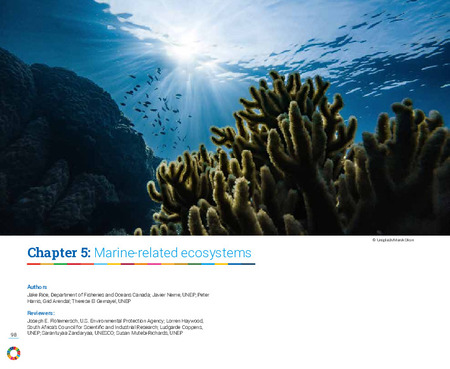| dc.contributor | Early Warning and Assessment Division | en_US |
| dc.contributor.author | Rice, Jake | en_US |
| dc.contributor.author | Neme, Javier | en_US |
| dc.contributor.author | Harris, Peter | en_US |
| dc.contributor.author | El Gemayel, Therese | en_US |
| dc.coverage.spatial | Global | en_US |
| dc.date.accessioned | 2023-03-22T07:59:45Z | |
| dc.date.available | 2023-03-22T07:59:45Z | |
| dc.date.issued | 2023-03 | |
| dc.identifier.uri | https://wedocs.unep.org/20.500.11822/42100 | |
| dc.description | SDG 14 is the dedicated goal towards the conservation and sustainable use of the oceans, seas and marine resources. This
goal includes 10 targets and 10 indicators related directly to marine-related ecosystems. Yet only three indicators represent a
picture of how the state of the environment is evolving: (a) SDG 14.1.1 on coastal eutrophication and plastic debris density, (b)
SDG 14.3.1 on the average marine acidity measured at agreed suites and (c) SDG 14.4.1 on the proportion of fish stocks within
biologically sustainable levels. However, only SDG 14.1.1a on coastal eutrophication, and more precisely the sub-indicator on
chlorophyll-a deviations, had data compliant with the requirements of the statistical analysis. The following analysis focuses on the interlinkages of chlorophyll-a deviations with identified drivers of change and state of human well-being indicators. | en_US |
| dc.format | pdf | en_US |
| dc.language | English | en_US |
| dc.publisher | United Nations Environment Programme | en_US |
| dc.relation.ispartof | Measuring Progress: Water-related Ecosystems and the SDGs | en_US |
| dc.rights | Public | en_US |
| dc.subject | marine ecosystem | en_US |
| dc.subject | Sustainable Development Goals | en_US |
| dc.subject | Sri Lanka | en_US |
| dc.title | Chapter 5: Marine-related ecosystems - Measuring Progress: Water-related Ecosystems and the SDGs | en_US |


